
Learning to play jazz guitar might seem like rocket science to some, and while there is a world of information and approaches out there, taking things in small steps will yield the best results.
Remember that music is not a competition. It is art for its own sake.
In this lesson, I'll attempt to give a general overview of the basics while being as comprehensive as possible. Further, this lesson does assume that you know the basics of music theory; building triads, basic scales, etc.
If you need a refresher on these things and more, with an emphasis on the relevance to guitar playing, JazzGuitarLessons.net is a great resource, as is our growing music theory column.
There's the assumption that, since you're interested in this topic, you've likely already become quite proficient at playing the guitar in general. That's great.
You've already won half the battle, especially if you have some music theory learning behind you. If that's the case, then you're definitely ready for...
One more thing before moving on, before getting into any new genre of music make sure you like it. If you don’t listen to it you won’t really understand it. It’s that simple. Ok, let’s get started.
Triad Shapes & Inversions
Most beginner and intermediate guitarists have not spent much time learning basic triad shapes and their inversions all over the fretboard.
They often feel like they have acquired enough through barre chords and open position shapes, and while these shapes will always be useful, they alone will not be sufficient in the complex jazz world.
Using triads and triad pairs as upper structures is beyond the scope of this lesson, but getting these under your belt will save you a lot of grief in the months to come.
Below, I’ve provided all of the necessary shapes for the G-chord. Learn where each chord tone is in each shape and you will be on your way to really developing your chord vocabulary.
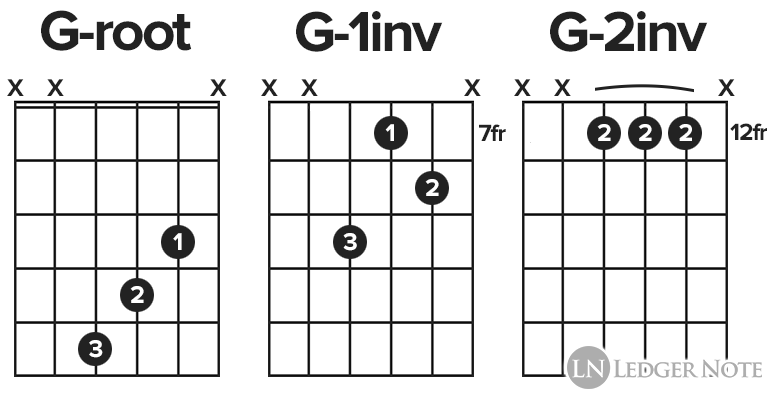
Move these around all over the fretboard and take these across the different sets of strings. You will have to adjust accordingly to move each chord around the different sets of strings as the 2nd and 3rd string are tuned to a major 3rd.
This will expand your knowledge of the fretboard while enabling you to access these shapes no matter where you are on the fretboard.
This section and the next are based on chord vocabulary. You will need to develop your chord vocabulary as much as possible to really be able to “comp” successfully.
Comping, by the way, is short for accompaniment. It basically just refers to the chords you are playing behind the soloist or the singer.
Shell Voicings for Beginner Jazz Guitar
Shell voicings are the first voicings I ever learned when I began studying beginner jazz guitar. They are called shell voicings because they only play the notes that determine the quality of the chord, leaving out the 5th. That means we have the 1st, 3rd, and 7th.
Guitarist Freddie Green of the Count Basie Orchestra was famous for using these types of voicings since big band arrangers often play around with the 5th, sometimes raising or lowering it. It helps to stay out of the way in these types of scenarios.
Additionally, using shell voicings as a foundation, you can start to find other color tones and really develop your vocabulary. But that’s another story for another day.
For this lesson, we will stick to building them off of the 5th and 6th strings.
6th string Voicings
Below is a selection of sixth string shell voicings in root position, not grouped in any particular order. Take special note that some are identical to others when the 5th scale degree is absent.

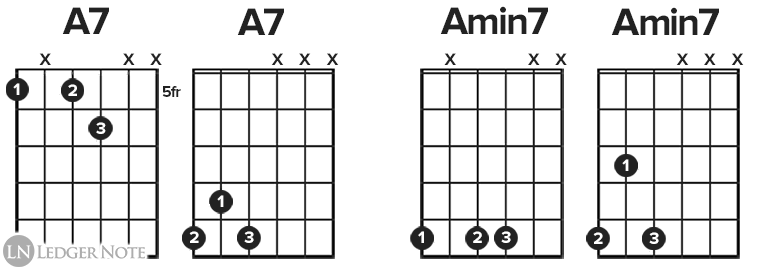
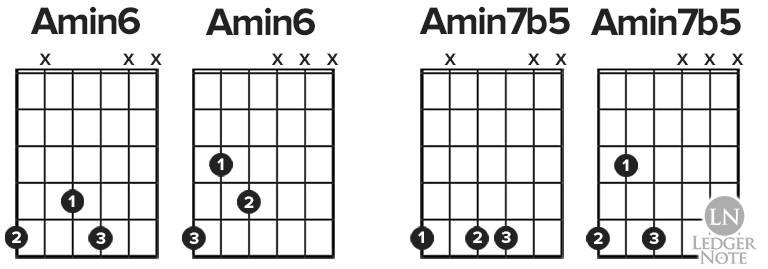

You probably noticed that the shapes for the min7 / min7b5 and the min6 / dim7 were not different. This is because they both leave out the 5th, as do all of these.
I thought it would be important to cover that so you are not surprised in a live setting. The same goes for these shapes on the 5th string.
5th String Voicings
The selection of fifth string shell voicings below exhibit the same peculiarities as those above when the 5th scale degree is left out, again all in root position.
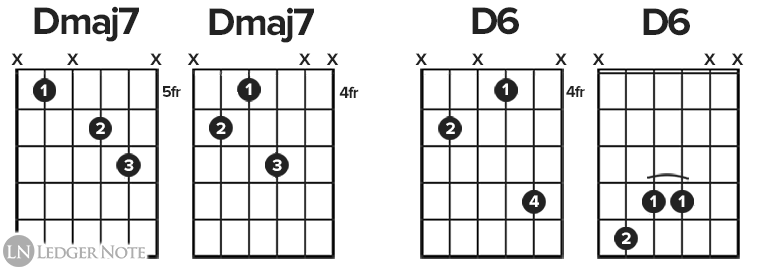
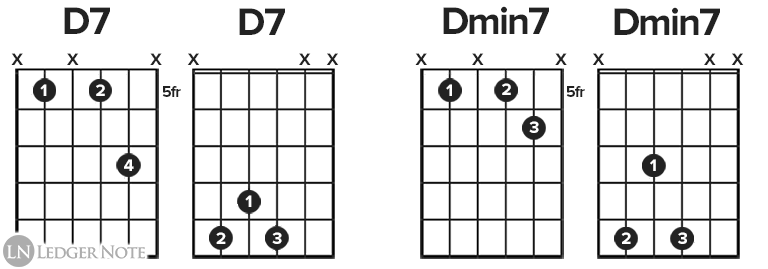
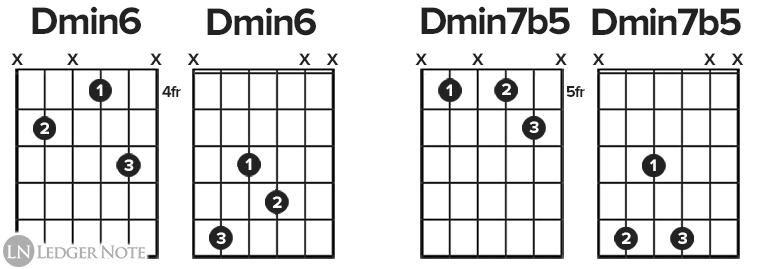
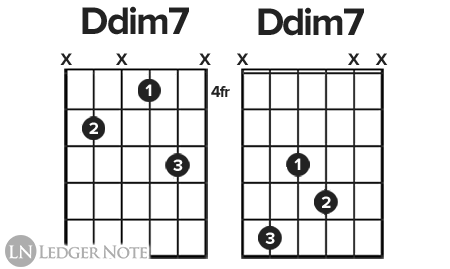
Once you’ve got all the shapes down, it’s important to begin applying them to tunes right away. As a beginner, I would recommend finding a chart for the tune “Autumn Leaves” to get started.
You can find countless copies of the chart for this song on Google Images and there are a ton of backing tracks on YouTube as well.
Voice Leading
When practicing this, it’s important to practice good voice leading as well. Voice leading, to give a quick explanation, is switching between chords using the closest notes possible.
Here are a couple of examples of ii V I progressions:
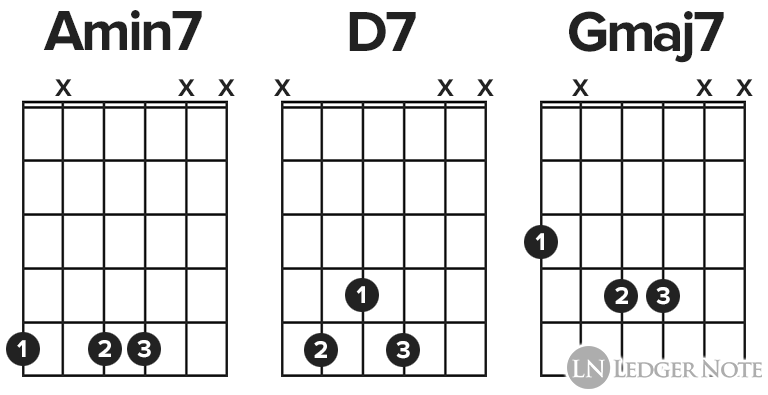
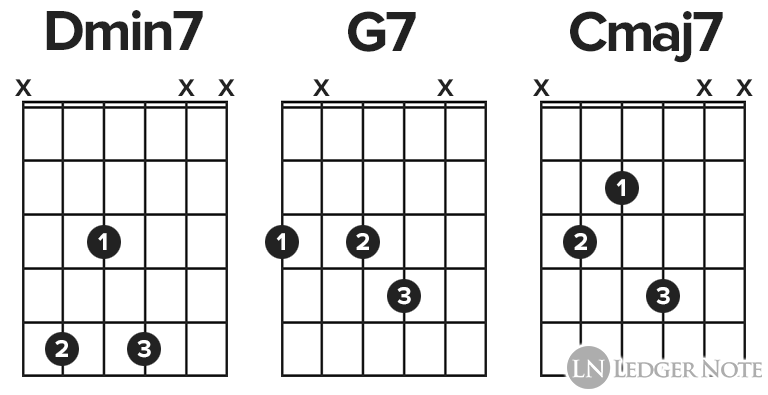
The ii V I progression is probably the most frequently used progression in jazz music. It is extremely important that you get it under your fingers in as many ways as you can with as many different ideas and phrases as possible.
This is bread and butter stuff through the subdominant, dominant, and tonic of your key. Anyway, you will notice how the 7th of the ii chord always shifts down to the 3rd of the V chord.
You also probably noticed how the 3rd of the ii chord became the 7th of the V chord. Study this. Become really familiar with these movements and you will be on your way.
I thought it might be a bit too much for an introductory lesson, but if you feel like you have got the material in this article down, I recommend doing some reading on the topic of drop 2 and 3 voicings. These are also incredibly useful!
Guide Tone Lines
Much like the deceptive simplicity of shell voicings, guide tone lines are also incredibly useful and can be developed into hip and modern sounding phrases.
Basically, the term 'guide tones' once again refers to hitting the important notes in the chord, those notes being the 3rd and the 7th. These phrases are also designed to make sure these guide tones are landing on the right parts of the beat, so to speak. Let’s go over that.
In order for it to really sound like you are hitting the changes, it’s important to make sure you are landing on down beats and not on the 'ands.' As you become more experienced, you will probably want to take liberties with this, but for now, it is important to master the basics.
Playing these chord tones on the downbeats and not the 'ands' will make the changes evident even without accompaniment in the background.
Just as with shell voicings, a great way to practice this is jumping right into a tune. In this case, you will want to target all of the ii V I progressions in the tune.
Note: Being able to spot ii V I chord progressions on the fly is extremely important.
Here are two good guide tone lines or phrases to get you started:
Dmin7 G7 Cmaj7
E :----------------|----------------|
B :----------------|----------------|
G :----2-5-4-2-----|----------------|
D :--3---------5-3-|2---------------|
A :5---------------|----------------|
E :----------------|----------------|
Dmin7 G7 Cmaj7
E :----------------|----------------|
B :----------------|----------------|
G :2-------------2-|----------------|
D :--3---------3---|5---------------|
A :----5-3-2-5-----|----------------|
E :----------------|----------------|In the case of minor key ii V i progressions, you’ll want to lower the 5th for the ii chord and the 3rd for the i chord.
Once again, a great tune to start with is “Autumn Leaves.” Begin by finding the ii V I progressions and see if you can hit them as they pass on your play-along track. There are also great play-along videos on YouTube that cycle through the ii V I progression in major and minor through every key.
Over time, you will see that you can develop these phrases and give them your own personal flair. For the time being, however, it is important to master the basics and make sure you can hit them in the right places. To break the rules, you must first know the rules!
Tone, Touch, & Vibrato
I find this aspect of learning any new style to be the most daunting and also the most important. If you have experience playing in genres such as blues or rock, you will have to work a bit extra to get used to not bending and using vibrato all the time.
If you listen to guys like Wes Montgomery, Pat Martino, Pat Metheny, etc., you rarely, if ever, hear them using any vibrato or bending. Jazz guitar players tend to prefer leaving the note as is.
Another important aspect of this topic comes in paying attention to the sustain of your notes. Paying attention to how players release or end the duration of a note and where is a very important part of sounding authentic and idiomatic.
It's not just the release, but the attack of the notes that help define a guitar player's tone. Pat Metheny has a way of picking that is so buttery smooth that his playing sounds like it's been passed through a compressor even when it hasn't.
Check out the Pat Metheny Group play some Jazz Fusion in their song First Circle live:
The best way to really get the hang of this is through transcribing, which leads me to the next topic!
Transcribing Licks
Transcribing is the act of learning something from another player by listening intently to what they are playing and writing it down. Sometimes, I skip the writing down part if I’m only trying to take a tiny snippet of something.
There is a great deal of debate on this particular method. Some guys say transcribing creates copycat players.
Others say the best way to learn and expand on your vocabulary as a player, and more importantly as an improviser, is to transcribe. I have a lot of respect for many players on both sides of the argument. I, however, tend to lean toward the latter.
It’s like in everyday language. You pick up phrases and learn how they are used mostly by listening and replicating them. If you liked how it sounded in casual conversation, you might use it again.
After a while, it becomes part of your regular vernacular. The same principle applies to transcribing, only there is a bit more work to be done.
Let’s say you are listening to a killer Wes Montgomery solo and you hear a lick that you really want to try for yourself. If you know the tune, you can pull up a chart - though I’d recommend learning tunes by ear from different versions - and see where in the tune that lick landed.
Then, you transcribe the lick and see how he approached a particular chord or progression with it. Really study where each note lands, dynamics, articulation, etc. Once that’s done, take the lick into your own playing.
Try it in different keys over different tunes. Eventually, it will have made its way into your playing. The goal here is to not have to think about using it, but to let it become part of your vocabulary.
Beginner Jazz Guitar Gear
I am of the opinion that a player should not obsess over gear early on, but rather, get the best possible sound with what he or she has available. Trying to buy your way into progress is an easy trap to fall into.
It's also important to note that a lot of the archtop hollow body guitars that jazz players are known for can get pretty expensive. The good ones, anyway. If you currently don’t have the proper equipment or the budget to acquire it, you can try a few things to get a “jazz” tone.
One thing I like doing on my strat is rolling off the tone knob a good bit. That tends to make things sound warmer. Skillful use of equalization also helps achieve this.
But back to the topic of proper gear. Usually jazz players have a specific set of tools. For one, they tend to prefer hollow or semi-hollow guitars, but of course there are exceptions.
Sometimes, to get some extra “roundness” to their sound, they might even use flatwound strings. I don’t love these as they tend to sound a little too dull for my taste. I like some brightness.
I have also heard mixed opinions on amplifiers. Some guys really like solid state amps as they seem to have a lot more headroom than a tube amp. With a tube amp, the sound breaks up at a much lower volume.
Personally, I tend to use tube amps as I play different styles and solid state just doesn’t cut it for some things, in my opinion, but both types make the cut in our list of best guitar amps.
Beginner Jazz Guitar is Easy!
So there you have it. It’s not rocket science and, in fact, most guys will tell you they try to think as little as possible in a live setting. The thinking and all that cognition happens in the practice room.
If you try to force things in a live setting, you will almost certainly lay an egg. Do all the practicing in the practice room and try to streamline your concepts as much as possible. Too much thinking is never a good thing.
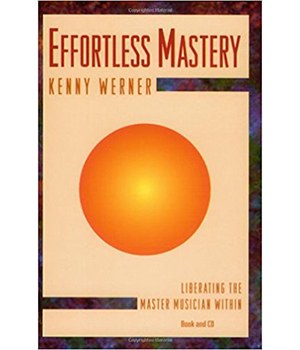
A great book on the topic of “not thinking” while performing is Kenny Werner’s Effortless Mastery.
Effortless Mastery is a highly recommended reading for any performer. But it is especially relevant to anyone just learning how to play guitar or embarking on the new journey of beginner jazz guitar.
As they say, practicing correctly is more important than how much you practice. Engraining bad habits into your playing can take a long time to undo.



















